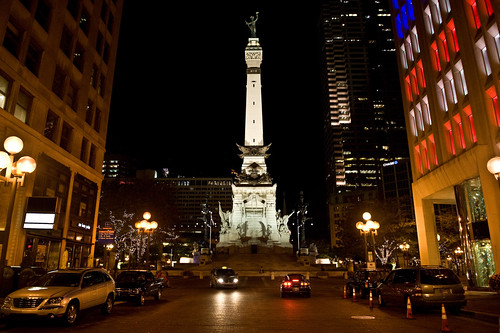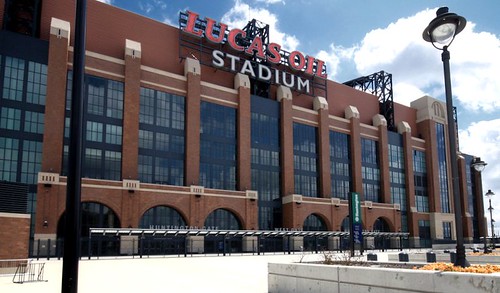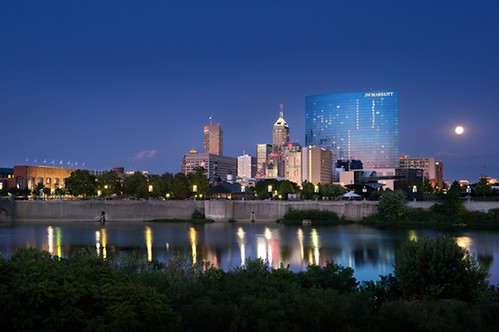A second winner at this year's Super Bowl: the walkable downtown

Posted February 10, 2012 at 1:37PM
I’ve had several occasions in the past three years or so to travel to Indianapolis, site of last Sunday’s Super Bowl. I am always struck, riding in from the airport, by how well Lucas Oil Stadium, where this year’s NFL championship game was held, fits architecturally within (or right next to, depending on your perspective) the city’s downtown. It’s an enormous building, to be sure, but the operative word here is “building,” which the stadium strives to be, with its neo-traditional brick design.
It’s about a six- or seven-block walk at most from Soldiers’ and Sailors’ Monument, the symbolic center of the city. Most of the city’s big hotels and restaurants are also nearby. Not that Indy isn’t also plagued by sprawl and disinvested neighborhoods, by the way, but its relatively compact, walkable downtown is loaded with convenience compared to the locations of most NFL football facilities. Indeed, Lucas Oil Stadium has a "very walkable" Walk Score of 72. (By contrast, FedEx Field, where the Washington Redskins play, rates only a "car-dependent" 28.)
This point was not lost on the members of the press who were in town for the game. The most articulate was probably Robert Niles of the trade site Theme Park Insider, who hails the advantages of urbanism for a city hosting a major entertainment event:
“Indy nailed this Super Bowl because of infrastructure. No, its football stadium isn't the biggest. Its hotels aren't the fanciest nor are its restaurants world-renowned. But they are packed together within walking distance of each other in Indianapolis' pedestrian-friendly downtown. Take a 20-minute cab ride from the city's new airport, and you don't have to get in a car again all week. The high density of attractions gave the city a critical mass, turning downtown into a multi-day street party . . .
“It's all about convenience and walkability. People don't want to have to spend a big chunk of their vacation in taxis or rental cars, as they did in Dallas at last year's Super Bowl. If you can offer people a destination where hotels, restaurants and attractions are all within easy walking distance, you're going to have an advantage over an alternative that requires people to get into their cars and drive for 10, 20, 30 minutes or more between where they stay, where they eat and where they play.”
Niles is in the business of tourism and entertainment, and thinking about what attributes are needed for his business to succeed in the coming years. Turns out they are the same as many other businesses are now seeking: city-based convenience. He continues:
“Walkability's been an emerging issue in urban and attraction development for years. But Indianapolis just illustrated the value of walkability to everyone in the tourism business, and at the same time. People involved in planning tourism attractions now have to ask themselves: Can I afford to give up the advantage of walkability to my competitors by building an old-fashioned, car-dependent, exurban-style development? Is my attraction really so alluring that I can get away with sticking people with the inconvenience of having to drive everywhere during their visit?”
[Emphasis mine]
Peter King, the lead writer on the NFL beat for Sports Illustrated, agrees:
“It's been a great game site for the Super Bowl. So much to do downtown, all on foot, and the natives and even the drunks are in great moods. The meteorologists have helped, but there's something to be said for a vibrant downtown hosting everything at a Super Bowl, and holding the Super Bowl in a place where you never have to get in a car.”
In a second article, King continued the praise by noting that he basically didn't need a car all week, and that the New York Giants’ downtown hotel was only four blocks from the stadium.
Writing last week on The Atlantic Cities website, Emily Badger noted that Indianapolis has also taken advantage of the Super Bowl – and some resulting investment money from the NFL – to add to its urban fabric. Most notable to this writer has been the building of a youth center that the city hopes can help revitalize the troubled Near Eastside neighborhood.
In addition, Indianapolis has altered a two-block stretch of a downtown street near the convention center so that it is now a sort of woonerf, or shared civic space where pedestrians and slow-moving motor vehicles have equal rights. While the concept may seem counter-intuitive to Americans whose traffic engineers have traditionally separated walkers and cars from each other in order to allow motor vehicles to move smoothly without hurting anybody, the international experience has been positive (woonerf means, roughly, “street for living” in Dutch). Seattle, among other American cities, has begun to employ the concept in selected locations.
It must be said that some of the city’s recent building boom may not appeal to all tastes. There’s a massive new JW Marriott hotel (see the image above from Emily’s article) that takes the opposite approach from neo-traditional Lucas Oil Stadium: it’s a sleek, modernist building that dwarfs everything around it and makes no apparent attempt to complement or blend visually with the rest of downtown. To me, it seems like the prodigal cousin who comes to the family reunion with his own boom-box playing very loud music, notwithstanding the quiet jazz trio that the family mainstays had already hired. But I suppose that’s a matter of personal preference.
To return to the very positive impression that Indy’s downtown made on Niles and King, what I find most encouraging is that these guys are not urban design or environmental professionals like yours truly. Rather, they are a businessman whose industry has long been dominated by automobile-dependent sites, and a sportswriter, respectively. Their experience with Indianapolis has made them into accidental, if enthusiastic, urbanists – and that’s a very good sign to those of us who are in this field that our faith in walkability is well-placed.
Move your cursor over the images for credit information.
Please also visit NRDC’s Sustainable Communities Video Channel.



